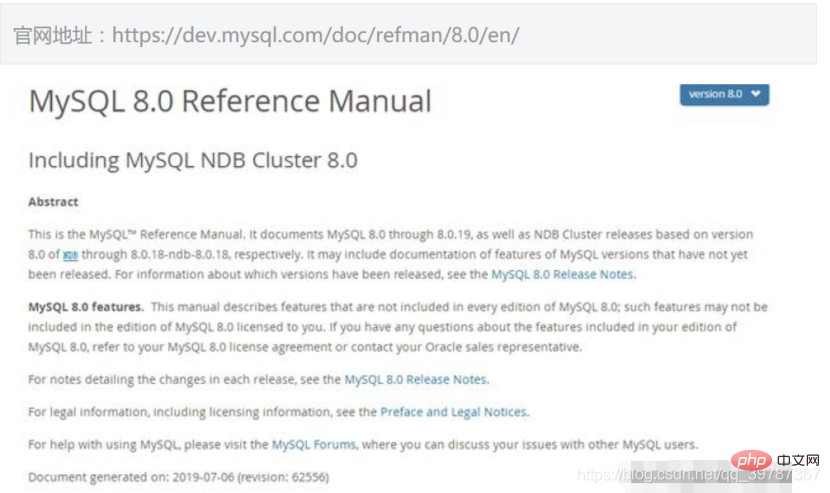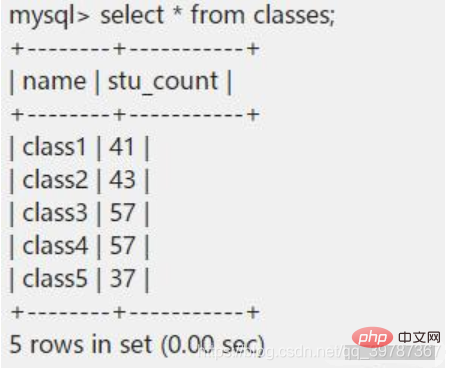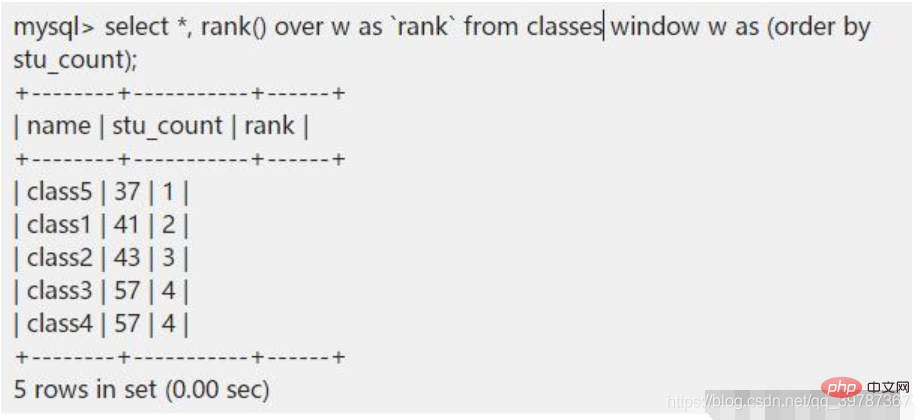What is the difference between mysql8.0 and mysql5.7?
Difference: The index of mysql8.0 can be hidden and displayed. When an index is hidden, it will not be used by the query optimizer; 2. Mysql8.0 has a new "SET PERSIST" command; 3 . Starting from mysql8.0, the default encoding of the database will be changed to utf8mb4, which includes all emoji characters.

(Recommended tutorial: mysql video tutorial)
mysql8.0 and mysql5. The difference between 7 is
1. NoSql storage
Mysql has provided NoSQL storage function from version 5.7. This part has been modified in 8.0, but this is not practical in practice. Very rarely used in 
2. Hidden index
The hidden index feature is very useful for performance debugging. In 8.0, the index can be hidden and displayed. When a When the index is hidden, it will not be used by the query optimizer
In other words, you can hide an index and then observe the impact on the database. If the performance drops, it means that the index is effective, so Just "restore the display"; if there is no change in the database performance, it means that the index is too large and can be deleted.
The syntax of hiding an index
ALTER TABLE t ALTER INDEX i INVISIBLE;
Restore the display The syntax of the index is:
ALTER TABLE t ALTER INDEX i VISIBLE;
When an index is hidden, we can see from the output summary of the show index command that the visible attribute value of the index is No
**Note:** When the index is hidden, its content is still updated in real time like a normal index. This feature itself is specifically used for optimization and debugging. If you hide an index for a long time, you might as well kill it because the existence of the index will affect the data. Insert\update and delete functions
3. Set persistence
MySQL settings can be changed at runtime through the SET GLOBAL command, but this change will only take effect temporarily until the next time The database will be read from the configuration file at startup.
MySQL 8 has added the SET PERSIST command, for example:
SET PERSIST max_connections = 500;
MySQL will save the configuration of this command to the mysqld-auto.cnf file in the data directory and start it next time The file will be read and the configuration in it will be used to overwrite the default configuration file.
4.UTF-8 encoding
Starting from MySQL 8, the default encoding of the database will be changed to utf8mb4, which includes all emoji characters. For many years, we have been careful in coding when using MySQL, for fear of forgetting to change the default latin and causing garbled code problems. No more worries from now on.
5. Common Table Expressions
Complex queries will use embedded tables, for example:
SELECT t1.*, t2.* FROM (SELECT col1 FROM table1) t1, (SELECT col2 FROM table2) t2;
With CTE, we can write like this :
WITH t1 AS (SELECT col1 FROM table1), t2 AS (SELECT col2 FROM table2) SELECT t1.*, t2.* FROM t1, t2;
In this way, the levels and areas look more distinct, and it is clearer to know which part to change when making changes.
This feature is very useful in many reporting scenarios and is also a very important feature of mysql optimization.
1.235 Window Functions
One of the most criticized features of MySQL is the lack of rank() function. When it is necessary to achieve ranking in the query, the @ variable must be written by hand. But starting from 8.0, MySQL has added a new concept called window function, which can be used to implement several new query methods.
The window function is a bit like an aggregate function such as SUM() and COUNT(), but it does not merge the multi-row query results into one row, but puts the results back into multiple rows. In other words, window functions do not require GROUP BY.
Suppose we have a table of "number of students in a class": 
If you want to rank the class size from small to large, you can use the window function like this: 
Description : A window named w is created here, and it is specified to sort the stu_count field, and then execute the rank() method on w in the select clause, and output the result as the rank field.
This feature is also a new feature of Oracle11g, and it also plays a very important role in optimization.
For more programming-related knowledge, please visit: Introduction to Programming! !
The above is the detailed content of What is the difference between mysql8.0 and mysql5.7?. For more information, please follow other related articles on the PHP Chinese website!

Hot AI Tools

Undresser.AI Undress
AI-powered app for creating realistic nude photos

AI Clothes Remover
Online AI tool for removing clothes from photos.

Undress AI Tool
Undress images for free

Clothoff.io
AI clothes remover

Video Face Swap
Swap faces in any video effortlessly with our completely free AI face swap tool!

Hot Article

Hot Tools

Notepad++7.3.1
Easy-to-use and free code editor

SublimeText3 Chinese version
Chinese version, very easy to use

Zend Studio 13.0.1
Powerful PHP integrated development environment

Dreamweaver CS6
Visual web development tools

SublimeText3 Mac version
God-level code editing software (SublimeText3)

Hot Topics
 When might a full table scan be faster than using an index in MySQL?
Apr 09, 2025 am 12:05 AM
When might a full table scan be faster than using an index in MySQL?
Apr 09, 2025 am 12:05 AM
Full table scanning may be faster in MySQL than using indexes. Specific cases include: 1) the data volume is small; 2) when the query returns a large amount of data; 3) when the index column is not highly selective; 4) when the complex query. By analyzing query plans, optimizing indexes, avoiding over-index and regularly maintaining tables, you can make the best choices in practical applications.
 Can I install mysql on Windows 7
Apr 08, 2025 pm 03:21 PM
Can I install mysql on Windows 7
Apr 08, 2025 pm 03:21 PM
Yes, MySQL can be installed on Windows 7, and although Microsoft has stopped supporting Windows 7, MySQL is still compatible with it. However, the following points should be noted during the installation process: Download the MySQL installer for Windows. Select the appropriate version of MySQL (community or enterprise). Select the appropriate installation directory and character set during the installation process. Set the root user password and keep it properly. Connect to the database for testing. Note the compatibility and security issues on Windows 7, and it is recommended to upgrade to a supported operating system.
 Explain InnoDB Full-Text Search capabilities.
Apr 02, 2025 pm 06:09 PM
Explain InnoDB Full-Text Search capabilities.
Apr 02, 2025 pm 06:09 PM
InnoDB's full-text search capabilities are very powerful, which can significantly improve database query efficiency and ability to process large amounts of text data. 1) InnoDB implements full-text search through inverted indexing, supporting basic and advanced search queries. 2) Use MATCH and AGAINST keywords to search, support Boolean mode and phrase search. 3) Optimization methods include using word segmentation technology, periodic rebuilding of indexes and adjusting cache size to improve performance and accuracy.
 Difference between clustered index and non-clustered index (secondary index) in InnoDB.
Apr 02, 2025 pm 06:25 PM
Difference between clustered index and non-clustered index (secondary index) in InnoDB.
Apr 02, 2025 pm 06:25 PM
The difference between clustered index and non-clustered index is: 1. Clustered index stores data rows in the index structure, which is suitable for querying by primary key and range. 2. The non-clustered index stores index key values and pointers to data rows, and is suitable for non-primary key column queries.
 MySQL: Simple Concepts for Easy Learning
Apr 10, 2025 am 09:29 AM
MySQL: Simple Concepts for Easy Learning
Apr 10, 2025 am 09:29 AM
MySQL is an open source relational database management system. 1) Create database and tables: Use the CREATEDATABASE and CREATETABLE commands. 2) Basic operations: INSERT, UPDATE, DELETE and SELECT. 3) Advanced operations: JOIN, subquery and transaction processing. 4) Debugging skills: Check syntax, data type and permissions. 5) Optimization suggestions: Use indexes, avoid SELECT* and use transactions.
 The relationship between mysql user and database
Apr 08, 2025 pm 07:15 PM
The relationship between mysql user and database
Apr 08, 2025 pm 07:15 PM
In MySQL database, the relationship between the user and the database is defined by permissions and tables. The user has a username and password to access the database. Permissions are granted through the GRANT command, while the table is created by the CREATE TABLE command. To establish a relationship between a user and a database, you need to create a database, create a user, and then grant permissions.
 Can mysql and mariadb coexist
Apr 08, 2025 pm 02:27 PM
Can mysql and mariadb coexist
Apr 08, 2025 pm 02:27 PM
MySQL and MariaDB can coexist, but need to be configured with caution. The key is to allocate different port numbers and data directories to each database, and adjust parameters such as memory allocation and cache size. Connection pooling, application configuration, and version differences also need to be considered and need to be carefully tested and planned to avoid pitfalls. Running two databases simultaneously can cause performance problems in situations where resources are limited.
 Explain different types of MySQL indexes (B-Tree, Hash, Full-text, Spatial).
Apr 02, 2025 pm 07:05 PM
Explain different types of MySQL indexes (B-Tree, Hash, Full-text, Spatial).
Apr 02, 2025 pm 07:05 PM
MySQL supports four index types: B-Tree, Hash, Full-text, and Spatial. 1.B-Tree index is suitable for equal value search, range query and sorting. 2. Hash index is suitable for equal value searches, but does not support range query and sorting. 3. Full-text index is used for full-text search and is suitable for processing large amounts of text data. 4. Spatial index is used for geospatial data query and is suitable for GIS applications.






